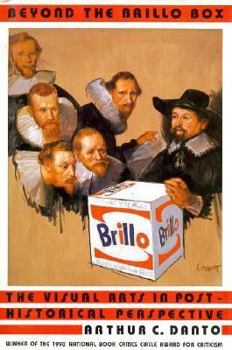Beyond the Brillo Box: The Visual Arts in Post-Historical Perspective
Select Format
Select Condition 
Book Overview
In Danto's view, Andy Warhol's Brillo Box was not only a radical attack on traditional definitions of the art work; it brought the history of Western art to a close. In this collection of interconnected essays, he grapples with this and many more of the most challenging issues in art today, from the problems of contemporary pluralism to the dilemmas of censorship and state support for artists.
Format:Hardcover
Language:English
ISBN:0374112428
ISBN13:9780374112424
Release Date:August 1992
Publisher:Farrar Straus Giroux
Length:263 Pages
Weight:1.55 lbs.
Dimensions:0.9" x 6.4" x 9.3"
Related Subjects
Art Arts, Music & Photography History & Criticism Philosophy Politics & Social SciencesCustomer Reviews
1 rating
Beyond the Brillo Box: The Visual Arts in Post-Historical Perspective
Published by Thriftbooks.com User , 16 years ago
Arthur C. Danto's Beyond the Brillo Box: The Visual Arts in Post-Historical Perspective, is somewhat of a prequel to the author's After the End of Art, and presents a group of collected essays on his perspective that "Andy Warhol's Brillo Box of 1964 brought the established trajectory of Western art to an end and gave rise to pluralism which has changed the way art is made, perceived, and exhibtited" (rear cover). He further explains within Brillo Box, and in the chapter on Learning to Live with Pluralism, that he previously published an essay entitled "The End of Art", but that it proposed "not that art would stop but that one reason for making art no longer had validity". Throughout the book, Danto revisits this very thesis, and in actuality the said previous scholarship seems to be the backbone of the text. Indeed, the later (1997) After the End of Art explains the idea of a paradigmatic or epochal change in much more concrete and palpable terms. When reading the first several chapters of Beyond, the reader has to work to find their bearings in Danto's non-linear style of writing. The concise introduction thus deceivingly pushes the average arts interested reader into somewhat less familiar territory, as the author consistently journeys into areas of philosophical interest such as his chapters on Metaphor and Cognition, and Narrative and Style. Danto should be given considerable credit, however, for his self-proclamation as first philosopher, and second art-critic. He seems to be more than aware of his position as a philosopher-critic, and has no pretensions of his work identifying itself as just art criticism. The work, as of 2009, will have been assembled 17 years prior (with many of the essays having been written considerably before the time of publication), and so, as with any text of its age--one might question the work's relevance to contemporary thought. There are several areas where the work engages in discourse that were certainly relevant to a widespread dialogue in 1992- such as Learning to Live with Pluralism, which the author presents at the time as an already eleven-year-old discussion. Pluralism remains, no doubt, a relevant and important point of discussion--it is however, a discussion that has been around for thirty years. Some of Danto's thoughts presented in the book become less an active voice in contemporary circles, and more a historical window into a not so distant past. Even with all that has been said, the author's writings still remain a fundamental influence to many later scholars. There are also seemingly timeless issues that the author discusses such as Censorship and Subsidy in the Arts, and the topic of Dangerous Art. Danto's probing into the fundamental and all too contemporary subject matter of government and public censorship and sponsorship of the arts is a well-articulated treatise on the topic. In a time of economic insecurity, the subject of where to spend public monies, and if art is the right des






